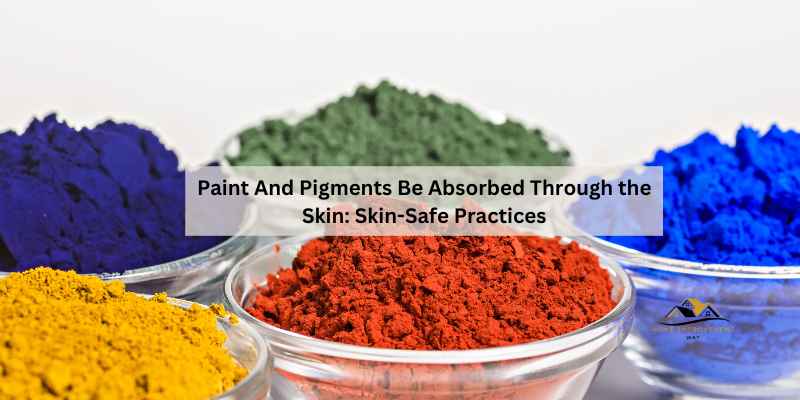Paint and pigments can be absorbed through the skin, although the extent of absorption depends on the chemical properties of the compounds and the integrity of the skin. Metal compounds such as cadmium, chromium, and inorganic lead used as paint pigments are primarily absorbed in the lung, but dermal absorption is generally low.
However, organic lead may be absorbed directly through the skin, especially among individuals who work with lead or lead-containing materials. Exposure to certain paint ingredients like acrylics and oil paints can pose health risks to the skin, including chemical burns, allergic reactions, and potential poisoning with prolonged contact.
While some chemical compounds can be absorbed by the skin, the risk depends mainly on their solubility in water, with insoluble pigments posing less risk of absorption. Therefore, it’s crucial to practice caution and proper safety measures when handling and using paints to minimize skin exposure and potential health hazards.
Common Paint Pigments
Paints and pigments are commonly used in various industries, including art, construction, and manufacturing. These pigments contain chemicals that give them their color and properties, and they can be absorbed through the skin, posing potential health risks.
Types Of Pigments Used In Paints
Paint pigments are categorized into different types based on their chemical composition and properties. Some common types of pigments used in paints include:
- Organic pigments
- Inorganic pigments
- Mineral pigments
- Synthetic pigments
Potential Health Risks Associated With Different Pigments
While many paint pigments are generally considered safe, some pose potential health risks when absorbed through the skin. It’s essential to be aware of the potential health risks associated with different pigments, including:
- Cadmium: Linked to lung absorption and potential skin absorption
- Chromium: Can be absorbed through the skin
- Lead: Inorganic lead may be absorbed directly through the skin
- Chemical Burns: Harsh ingredients in certain paints can cause chemical burns and allergic reactions
Artists and individuals working with paints should take precautions to minimize skin contact and ensure proper ventilation to reduce the risk of exposure to harmful pigments.
Skin-safe Practices

Protective Measures For Artists
Artists should wear protective gear like gloves and aprons to minimize skin contact with pigments.
Regularly wash hands and exposed skin areas to remove any paint residue.
Avoid eating, drinking, or smoking while working with pigments to prevent ingestion.
Proper Ventilation And Safety Equipment
Ensure the workspace is well-ventilated to reduce inhalation of harmful fumes.
Use appropriate safety equipment such as masks and goggles to protect the eyes and respiratory system.
Dispose of waste materials properly to prevent environmental contamination.
Specific Risks For Artists
Dermal Absorption Of Lead In Paints
Metal compounds like cadmium, chromium, and inorganic lead are mainly absorbed in the lung, with low dermal absorption depending on compound properties.
Toxicity Concerns With Acrylics And Oil Paints
Acrylics and oil paints can cause chemical burns, allergic reactions, and poisoning upon prolonged skin contact due to harsh base ingredients.
Health Effects Of Paint Absorption
When paint and pigments come into contact with the skin, there is a potential for absorption, which can lead to various health effects. It’s important to understand the potential risks and implications associated with paint absorption through the skin.
Chemical Burns And Allergic Reactions
Exposure to certain chemicals in paint can result in chemical burns when they come into contact with the skin. Additionally, some individuals may experience allergic reactions upon skin absorption of certain paint components, leading to redness, itching, and discomfort.
Long-term Health Implications
Long-term exposure to paint absorption through the skin can have serious health implications. Continuous contact with harmful paint components may lead to chronic health issues, affecting the overall well-being of an individual.
Minimizing Exposure
- Always store paints in well-ventilated areas away from direct sunlight and heat sources.
- Use airtight containers to prevent evaporation and spills.
- Label containers clearly with the type of paint and date of purchase.
- Dispose of old or unused paints properly following local regulations.
- Wear protective clothing such as gloves, long sleeves, and pants to minimize skin contact.
- Use barrier creams or lotions before handling paints to create a protective layer on the skin.
- Immediately wash off any paint that comes in contact with the skin using mild soap and water.
- Regularly inspect skin for any signs of irritation or redness after working with paints.
Regulatory Guidelines
Occupational Safety Regulations For Artists
Artists must adhere to strict safety regulations to minimize exposure to harmful paint pigments.
- Avoid direct skin contact with toxic pigments like cadmium and chromium.
- Wear appropriate personal protective equipment such as gloves and aprons.
- Proper ventilation in art studios to reduce inhalation risks.
Best Practices For Paint Use In Art Studios
Implementing best practices ensures a safe environment for artists working with paint:
- Store paint containers properly to prevent spills and leaks.
- Regularly clean work surfaces to avoid cross-contamination of pigments.
- Dispose of hazardous waste following local regulations to protect the environment.

Frequently Asked Questions
Can Paint Be Absorbed Through The Skin?
Metal compounds used as paint pigments such as cadmium, chromium, and inorganic lead can be absorbed through the skin, but dermal absorption is generally low and depends on the chemical properties of the compound, the vehicle, and the integrity of the skin.
Organic lead may be absorbed directly through the skin, but it is less likely than inorganic lead. However, repeated contact with harsh ingredients in spray paints, acrylics, and oil paints can cause chemical burns, allergic reactions, and poisoning if contact with the skin is prolonged and over large areas.
Can Lead Paint Be Soak Into Skin?
Lead paint can be absorbed into the skin, especially organic lead. However, dermal absorption is generally low and depends on the chemical properties and the integrity of the skin. It’s more likely among people who work with lead or lead-containing materials.
Is Acrylic Paint Toxic To Skin?
Acrylic paint can be harsh on the skin, causing chemical burns, allergic reactions, and potential poisoning with prolonged contact.
Is It Bad To Get Oil Paint On Your Skin?
Oil paint can be absorbed through the skin, especially if it contains toxic metals like lead. It’s important to keep paint off your skin to avoid absorption. Skin is a sponge for substances, so avoiding contact is crucial.
Conclusion
While some paint pigments can be absorbed through the skin, the risk varies depending on the chemical properties of the compound and the skin’s integrity. Artists should take precautions to minimize direct skin contact with potentially harmful pigments to avoid potential health risks.
It is essential to prioritize safety measures when working with paint to protect skin health.


